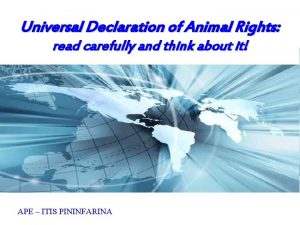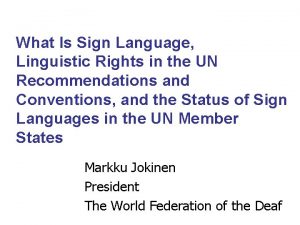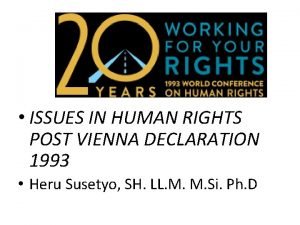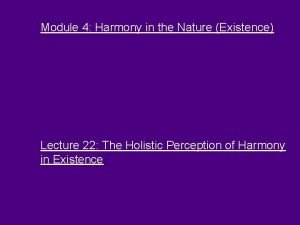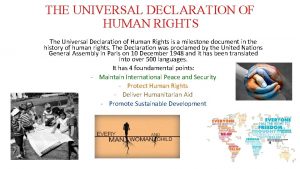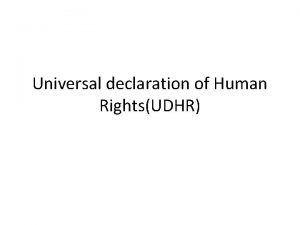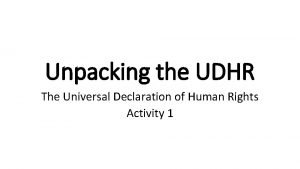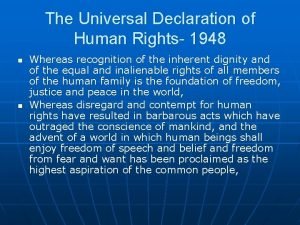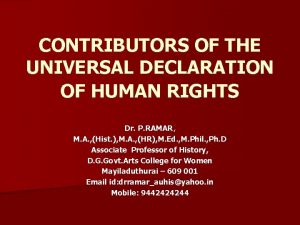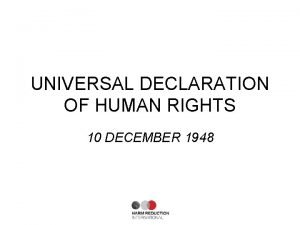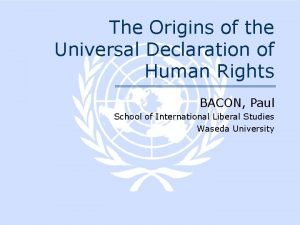UNIVERSAL DECLARATION OF HUMAN RGHTS UNHR Was the











- Slides: 11

UNIVERSAL DECLARATION OF HUMAN RGHTS (UNHR) Was the UNDHR only a Western manifesto without universality ? Discuss the ‘Asian values’ and Moslem critique debates.

Definition l Internationally agreed values, standards rules or regulation. Baehr(1999) Universal respect for ALL and observance of human rights and fundamental freedoms for all without distinction as to race, sexual orientation, language, or religion Purpose l ‘international cooperation in solving international problems of an economic, social, cultural, or humanitarian character, and in promoting and encouraging respect for human rights and fundamental freedoms for ALL l The preamble to the UNDHR states that … ‘recognition of the inherent dignity and the equal rights of all members of the human family is the foundation of freedom , justice and peace in the world’. l

? Is the UNDHR only a Western manifesto without universality Eleanor Roosevelt – Chairperson General Assembly at the time said the declaration was, ‘first and foremost a declaration of the basic principles to serve as a common standard for all nations’. A commission consisting of Asians, Indians, Soviets, Latin Americans, Eastern Europeans & Western Europeans. It set up a committee which did three things namely: l Philosophers submit ideas from all persuasions l Solicited ideas from organisations and educational communities l Enquiries and proposals of what HR ought to be

The Legal Status of the Universal Declaration of Human Rights Not legally binding l It is commonly accepted as the ‘core rights’ in the Universal Declaration l It is largely regarded as binding international customary law. l It is the most widely translated and circulated document in human history. It creates a moral momentum that does not necessary have states behind. l

Universality Universal human rights are premised on the assumption that they reflect universally accepted norms of behaviour. l Human rights are ordinarily understood to be rights that one has simply because one is human. As such they are equal as one is either are or not human l Human rights are also inalienable because being or not being human is seen as an inalterable fact of nature, not something that is either earned or lost. l At least fifty six countries contributed to the writing of the Declaration. The different cultures, religions and philosophies were inculcated in one form or the other into the ideals of the declaration. Forty eight nations approved it, many more eventually signed it. l It’s universality was reaffirmed at the World Conference on Human Rights in Vienna, 1993. At least two thousand delegates from more than 171 affirmed their commitment to the vision of the UNDHR as a common standard for all peoples and nations by unequivocally declaring: ‘The Universal nature of these rights and freedom is beyond question’. l In the UN the principles of the UNDHR underpin covenants, conventions, treaties, international customary law and declarations. l Amongst nations , the principles are evident in domestic legislation, democratic movements and in constitution. Eg the adoption of the bill of rights confers a guarantee of certain basic rights in many countries ; Canada, Indonesia, Jordan and Haiti to name a few. l On an international level the principles of the UNDHR are evident in international charters such as the European convention on Human Rights (1950), the African Charter on Human and Peoples’ Rights (1981) l

UNDHR…. A Foregone Conclusion l l 1). It was drafted at a time when most Third World nations were still under colonial domination; developing countries that later incorporated the standards in their national constitutions accepted the declaration either as members of the Organization of American States or the Organisation of African Unity, did so under pressure from West. 2). Rights contained in the Universal Declaration are a reflection of mainly western ideological views as opposed to the values of dominant non-western societies.

Abstention l Although the vote for the Universal Declaration of Human Rights was unanimous; eight states – the Soviet Union and five of its allies as well as Saudi Arabia and South Africa abstained. WHY ? South Africa rejected the principle of equality stated in Article 1 and 2. Soviet Union abstained because it felt the attention or recognition for national sovereignty was inadequate Saudi Arabia’s abstention was as a result of the inclusion of the freedom religion and the right to change one’s religion

Asian Values l l l Asian countries such as Indonesia, China, Singapore, and Malaysia are cited as being critical of the concept of human rights the preamble of the Bangkok Declaration emphasises the universality, objectivity and non selectivity of all human rights and the need to avoid double standards in its implementation; The complex cultural reality here is that human rights are general principles that have been interpreted in the light of the world’s diverse culture.

Muslim Critique l l The Islamic Position provides differing opinions on the concept of how human rights and Islamic requirements fit together. The argument that human rights do not represent an all encompassing way of life; neither does it provide a yard stick to evaluate cultures and religions in general. Certain Islamic practices and laws contradict human right principles enshrined in the declaration. Article 16 and 18. The emancipatory principle of human rights presents a challenge to the Islamic tradition.

Conclusion l The growth and acceptance of the Declaration has been phenomenal. There are currently over two hundred declarations, conventions, protocol, treaties, charters and agreements that deal with the realisation of human rights. Most of these make mention of the Universal Declaration of Human Rights as a source of authority and inspiration. In spite of the criticisms, the Universal Declaration of Human Rights ; a document written by the UN Commission led by Eleanor Roosevelt; adopted on the 10 th of December 1948 has become the moral backbone for more than two hundred human rights instrument resulting from international negotiation. It plays a significant role in our world today and continues to be a source of inspiration and hope to millions of oppressed in the world.

Non governmental organisations in Asia at the signing of the Bangkok Declaration in 1994 held that states were ‘cynically interested in nothing more than creating a shield under the expression of “cultural relativism” to protect themselves against criticism and accountability. Lauren(1998) Is this a viable argument?
 The universal declaration of animal rights
The universal declaration of animal rights Universal declaration of linguistic rights
Universal declaration of linguistic rights Vienna declaration of human rights
Vienna declaration of human rights Universal ingredients of human communication
Universal ingredients of human communication Holistic perception of harmony in existence
Holistic perception of harmony in existence Hát kết hợp bộ gõ cơ thể
Hát kết hợp bộ gõ cơ thể Bổ thể
Bổ thể Tỉ lệ cơ thể trẻ em
Tỉ lệ cơ thể trẻ em Gấu đi như thế nào
Gấu đi như thế nào Thang điểm glasgow
Thang điểm glasgow Hát lên người ơi alleluia
Hát lên người ơi alleluia
